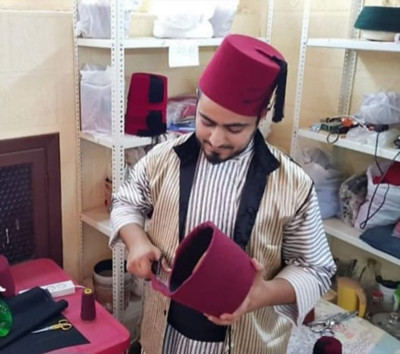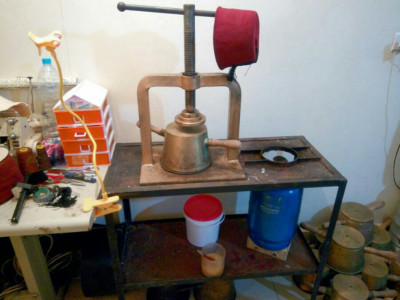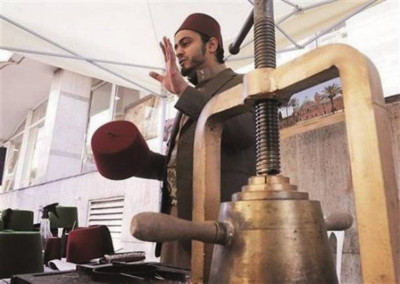Tarbush
 The tarbush, found in Lebanon, as well as in Palestine, Syria, and Jordan, is a flat-topped men’s hat that is red, cone-shaped, made out of felt and topped with a silk tassel.
The tarbush, found in Lebanon, as well as in Palestine, Syria, and Jordan, is a flat-topped men’s hat that is red, cone-shaped, made out of felt and topped with a silk tassel.
In Lebanon, tarbush-making is an inherited profession that parents pass down to their children. However, today, very few people carry on this trade. The production of the tarbush is considered difficult and requires high-precision as it involves multiples stages. Only three artisan families in Tripoli (Chaar family), Beirut (Al-Hajj Abu Akram), and Saida (Abu Zeinab family) still produce it.
 The process of making a tarbush starts with obtaining the necessary fabric, which is imported from the Czech Republic. It is then detailed according to the size of the tarbush mold, which can range from 25 cm to 80 cm. The fabric is stretched over the mold, supported by wooden pieces imported from Morocco. A leather strip is sewn by hand on the inside to prevent sweating. The production of one tarbush takes approximately three hours.
The process of making a tarbush starts with obtaining the necessary fabric, which is imported from the Czech Republic. It is then detailed according to the size of the tarbush mold, which can range from 25 cm to 80 cm. The fabric is stretched over the mold, supported by wooden pieces imported from Morocco. A leather strip is sewn by hand on the inside to prevent sweating. The production of one tarbush takes approximately three hours.
 This unique style of headdress spread to the Levant and Egypt during the Ottoman Empire. The tarbush became an integral part of the uniform for employees in the Ottoman Empire after it was declared an official head cover by Sultan Mahmoud II Ferman. Initially, it was associated with specific well-known families in Lebanon, such as the Arslan family, the Salam family, the Khazen family, and other families that played a significant political role in Lebanon’s history. Over time, it became popular across all social classes. However, due to the numerous political and sociocultural changes that took place in the country in the 1960s, the tarbush slowly phased out of people’s lives. It eventually disappeared during the civil war (1975-1990).
This unique style of headdress spread to the Levant and Egypt during the Ottoman Empire. The tarbush became an integral part of the uniform for employees in the Ottoman Empire after it was declared an official head cover by Sultan Mahmoud II Ferman. Initially, it was associated with specific well-known families in Lebanon, such as the Arslan family, the Salam family, the Khazen family, and other families that played a significant political role in Lebanon’s history. Over time, it became popular across all social classes. However, due to the numerous political and sociocultural changes that took place in the country in the 1960s, the tarbush slowly phased out of people’s lives. It eventually disappeared during the civil war (1975-1990).
Nowadays, wearing a tarbush has become less common in Lebanon. It is still worn by some people, such as Sunni or Druze clerics who pair it with a white turban, as well as by people who work in folk troupes or historical sites to attract tourists. During the holy month of Ramadan, the tarbush has become a traditional or folkloric part of the mesaharati’s attire. It is also worn by workers in restaurants, hotels, and Ramadan tents to evoke the popular heritage of the holy month. Although its popularity has diminished, many people believe that the tarbush industry should be preserved as an integral part of Lebanon’s heritage. Some designers are working to reintegrate the tarbush as an accessory in their new collections.

